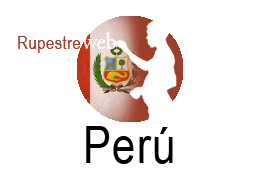
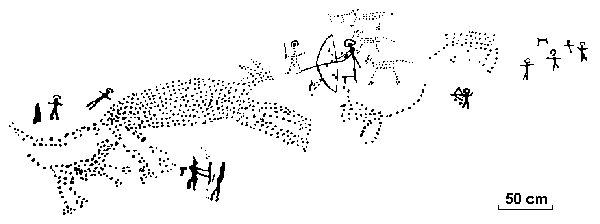 |
Figure 1. The main panel at Achahui, Provincia de
Espinar, Departamento de Cusco, Perú.
|
In his article Rainer Hostnig
mentions four other rock art sites in the Andes where the same technique occurs
in zoomorphic images (Sincho Colorado and Coimata in Bolivia; Cerro Colorada
and - only mentioned, not illustrated by Carlos Aschero [1988] - Antofagasta de
la Sierra in Argentina), but he also remarks that “La técnica de producción de petroglifos
mediante el tratamiento puntiforme sin uso de líneas de contorno .... es poco
común en el arte rupestre andino y representa (hasta ahora) un unicum en el
arte rupestre del sur peruano”.
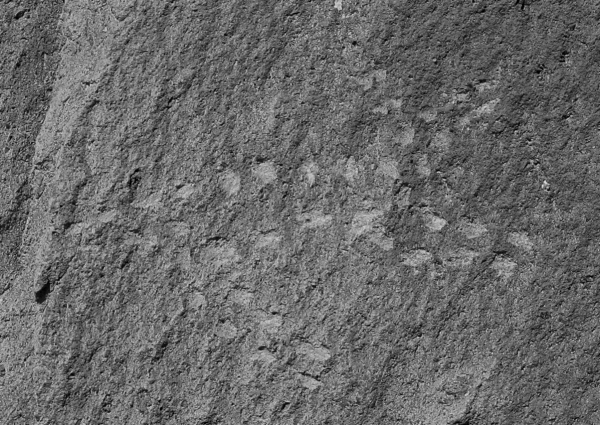 |
Figure 2. Completely dotted zoomorphic petroglyph from the Majes Valley, southern Peru. |
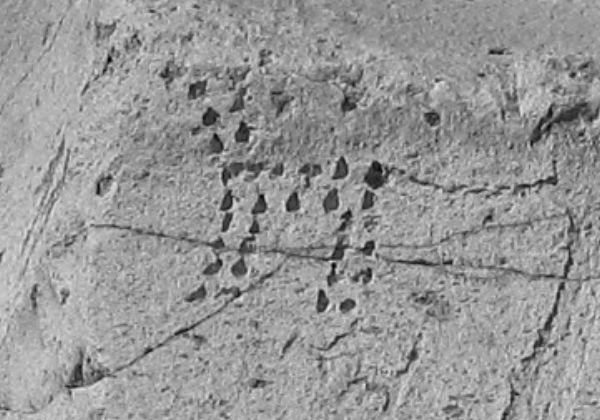 |
Figure 3. Completely dotted zoomorphiglyph from the Majes Valley, southern Peru.
|
When one notices a completed
dotted zoomorphic petroglyph without contour lines, it does not mean that
contour lines were not necessarily intended to be present. The manufacturer may well have abandoned the image (as I will
demonstrate with examples in the third group; see Figure 15) or perhaps he or
she decided not to create a fully pecked image (see Figure 14). Figure 4 shows
a completely dotted zoomorph (framed) - apparently looking to the right - that
may well have been intended to receive an outline, resembling the dotted
zoomorph above the frame. The dotted and outlined zoomorphs of the Majes area are a true hallmark of the rock art
iconography of that region and thus it can be expected that unfinished examples
occur.
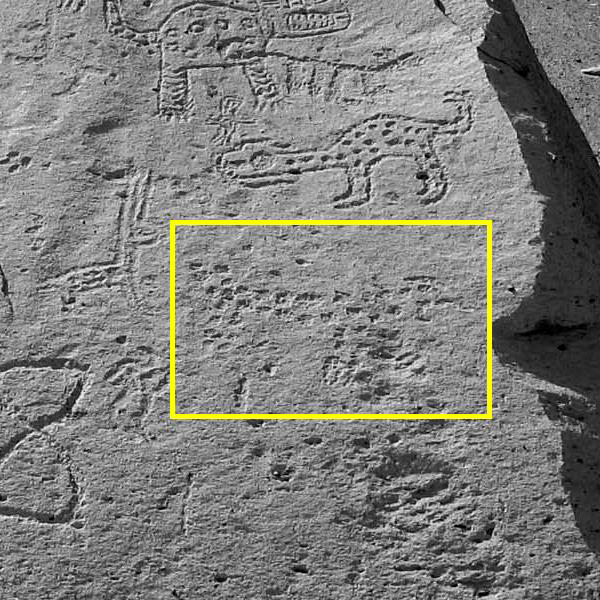 |
Figure 4. Completely dotted zoomorphic petroglyph (framed) from the Majes Valley, southern Peru. |
In some cases it is hard to
discern a zoomorph in an apparently unorganised chaos of dots. Two special
examples are shown in Figures 5 and 6. The dotted petroglyph in Figure 5 may
well depict a zoomorph; a fish or a frog perhaps? Figure 6 shows two dotted
petroglyphs. The arrangement on the left may represent the image of a large frog
seen in bird’s eye view. At this site also several abstract images proved to
have been manufactured with only small dots; not cupules, though (Van Hoek 2012:
122, 123 and 124).
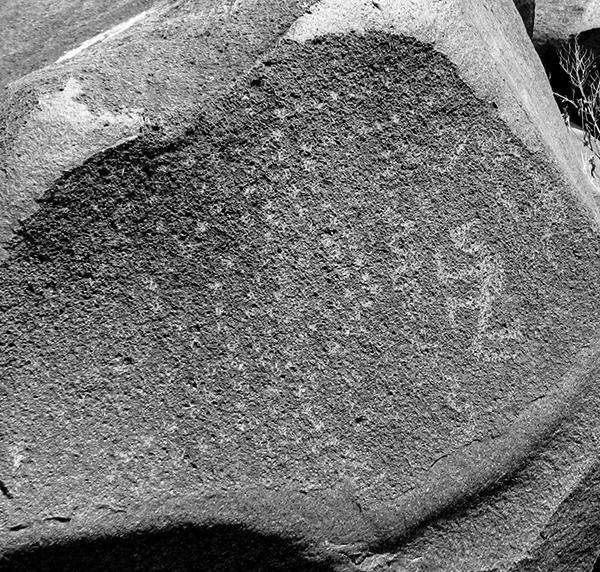 |
Figure 5. Completely dotted zoomorphic petroglyph from the Chancay Valley, northern Peru. |
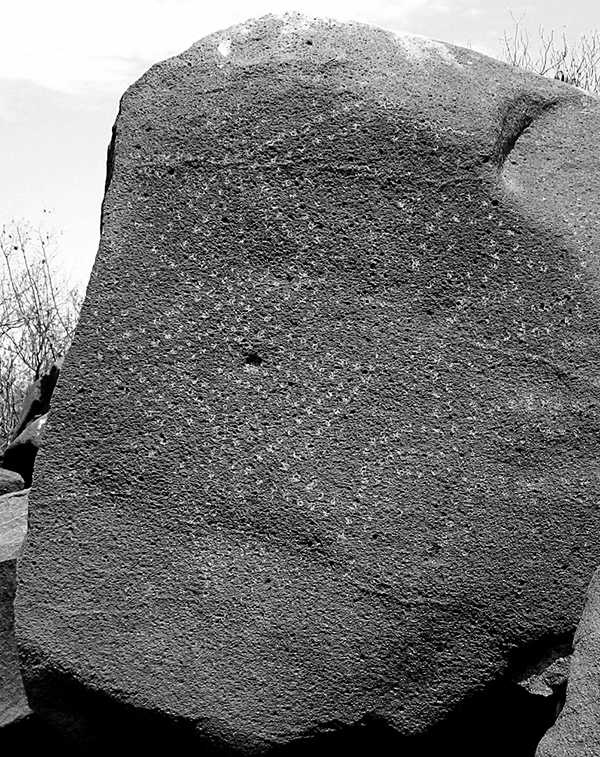 |
Figure 6. Completely dotted zoomorphic petroglyph from the Chancay Valley, northern Peru. |
GROUP II: The second category
comprises images that are almost entirely
made up of dots. Only specific body parts are fully pecked and in most instances
it concerns the head. Figure 7 shows the petroglyph from the Majes Valley of a
dotted zoomorph similar to Figure 3, except that the head is drawn as a
V-shaped line. The dotted petroglyphs in Figures 8 and 9 clearly show their
heads as fully pecked (thus not dotted) areas, clearly showing the ears. It seems that those three petroglyphs
represent dotted zoomorphs, without the intention to replace the whole figure
with a fully pecked body. What's more, especially the head most likely was
executed fully pecked intentionally. This confirms my theory that in rock art
the main focus is often on the head (see for instance Van Hoek 2005/6; 2015a
and 2015b)
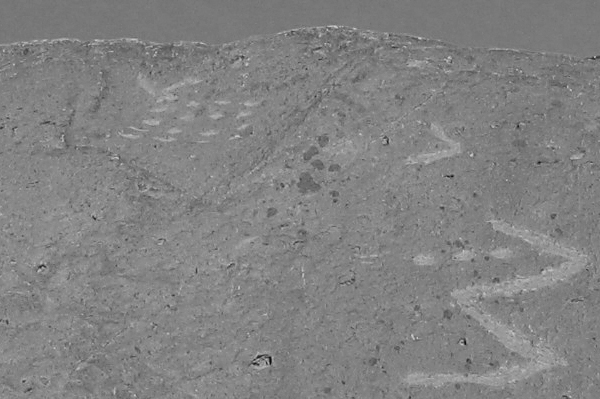 |
Figure 7. Dotted zoomorphic petroglyph from the Majes Valley, southern Peru. |
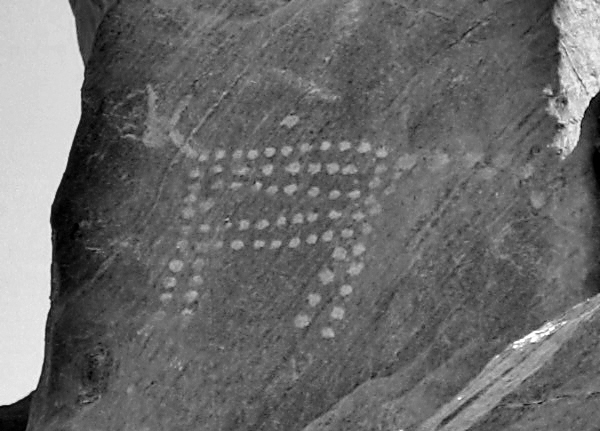 |
Figure 8. Dotted zoomorphic petroglyph from the San Juan Valley, southern Peru.
|
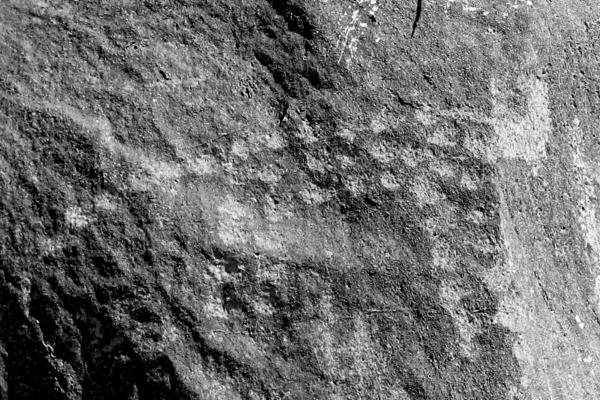 |
Figure 9. Dotted zoomorphic petroglyph (‘feline’?) from the San Juan Valley, southern Peru. |
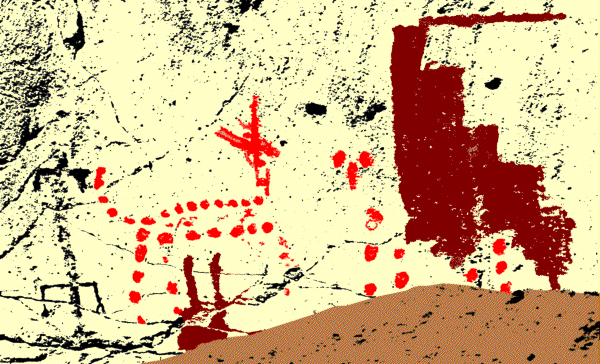 |
Figure 10. Dotted zoomorphic rock painting(s?) from the Quebrada de Camiña, northern Chile.
|
Also found in northern Chile is an
extensive rock art site in the Valle de Lasana; part of the Upper Loa Valley.
In the Sector of Chacras Viejas at Chiuchiu is a vertical rock panel, located
rather high up the steep slope. One of three decorated panels bears the
petroglyphs of two large dotted zoomorphs (possibly ‘felines’) that are associated
with two anthropomorphic figures (the fainter anthropomorph - green arrow - is missing
in Figure 11). However, Rainer Hostnig (2011) remarks that those ‘felines’ “... fueron producidas mediante el delineado y no a través
del punteado del contorno o del cuerpo entero”. Hostnig probably referred to the drawing in an inventory of the rock art
at Lasana (Rojas 2005). On page 97 of this inventory is a drawing of the two
zoomorphic petroglyphs in which, however, some flaws can be spotted (Figure 11).
The larger (upper) ‘feline’ is almost entirely made up of dots, although much of its tail also comprises small rectangular ‘dots’. Moreover, its head has been drawn with grooves. The two front legs (one emerging from the head) are also made of pecked grooves. The drawing only features one hind leg (blue arrow in Figure 11), while actually there are two, both comprising superficially pecked grooves, not dots. The smaller ‘feline’ only seemingly has no head. But on inspection of the panel it proves to have a small head after all (yellow arrow in Figure 12). As the head may be regarded as a large dot, the smaller feline is the only petroglyph that is completely made up of dots (disregarding the fact that also its tail comprises small, isolated rectangles). Although the drawing does not show any hind legs (red arrow in Figure 11), the dotted extremities are clearly visible in the photo (Figure 12).
 |
Figure 11. Dotted zoomorphic petroglyphs from the Valle de Lasana, northern Chile.
|
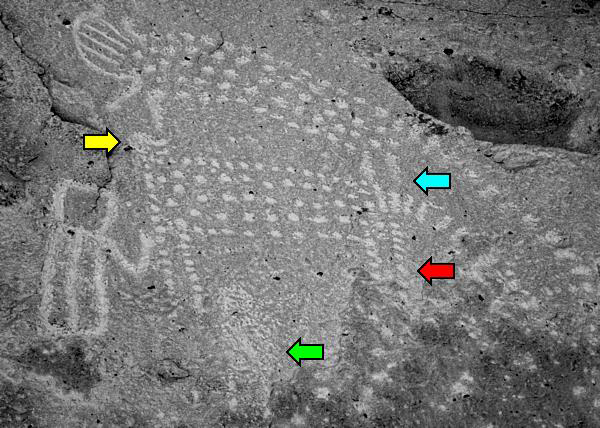 |
Figure 12. Dotted zoomorphic petroglyphs from the Valle de Lasana, northern Chile.
|
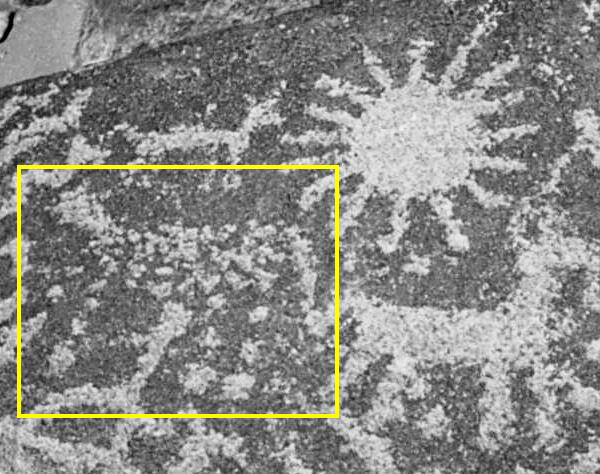 |
Figure 13. Dotted zoomorphic petroglyph from the Quebrada de Tarapacá, northern Chile.
|
In the Majes Valley, southern
Peru, is a medium-sized boulder with a dotted zoomorph (probably a camelid)
that is made up of large dots (Figure 14). However, as the two legs are clearly
fully pecked, this probably represents an unfinished petroglyph, as most likely
it was the intention to produce a completely fully pecked zoomorph.
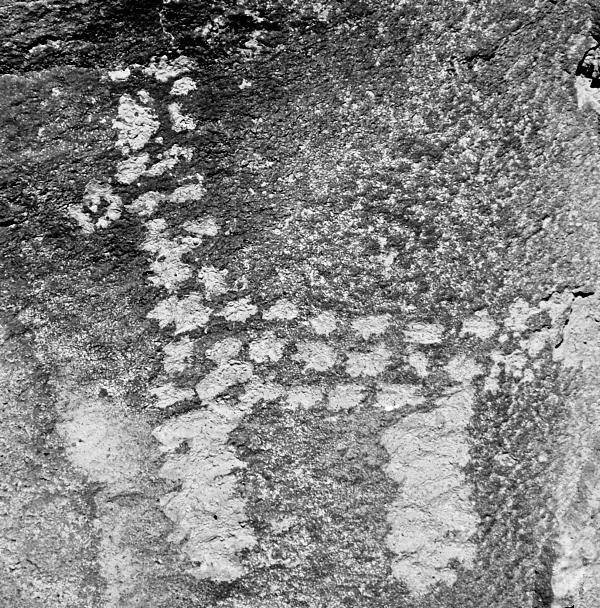 |
Figure 14. Partially dotted zoomorphic petroglyph from the Majes Valley, southern Peru.
|
GROUP III: The third group encompasses images that are made up of dots, but that are partially outlined. Most likely the rare examples of this group represent abandoned attempts to manufacture a completely outlined, but still dotted, image. Figure 15 clearly shows a dotted zoomorph, of which only part of the contour groove was completed. The head most likely has flaked off (it is therefore uncertain whether the animal looks to the right or to the left). Figure 16 shows two groups of small cupules that look like the curved bodies of ‘felines’. This interpretation is confirmed by the isolated but outlined head of a Majes Style ‘feline’ that ‘floats’ very near the uppermost group of dots (yellow arrow in Figure 16).
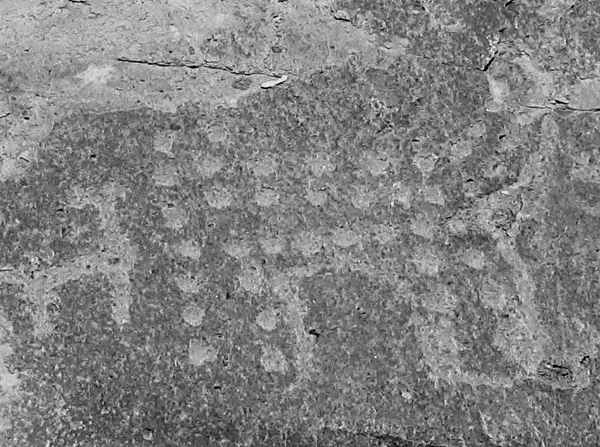 |
Figure 15. Unfinished zoomorphic petroglyph from the Majes Valley, southern Peru.
|
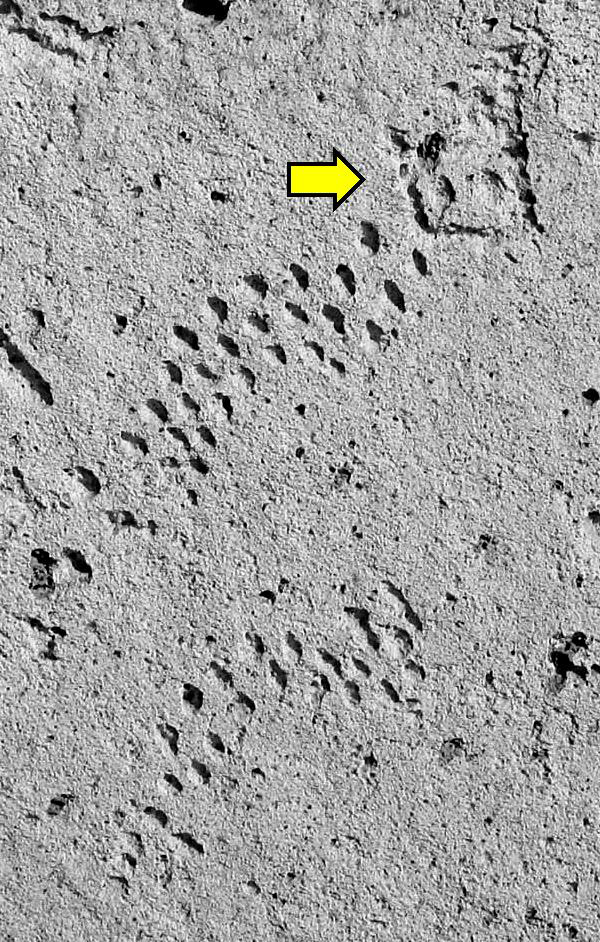 |
Figure 16. Unfinished zoomorphic petroglyphs (felines?) from the Majes Valley, southern Peru.
|
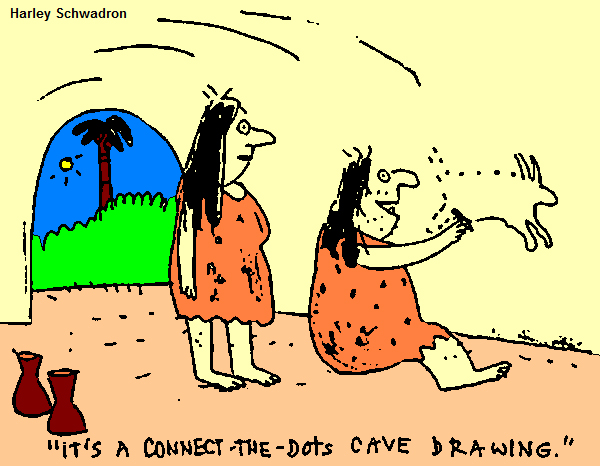 |
Figure 17. “Ancient artists connecting dots”. Cartoon by Harley Schwadron, coloured in by the author. |
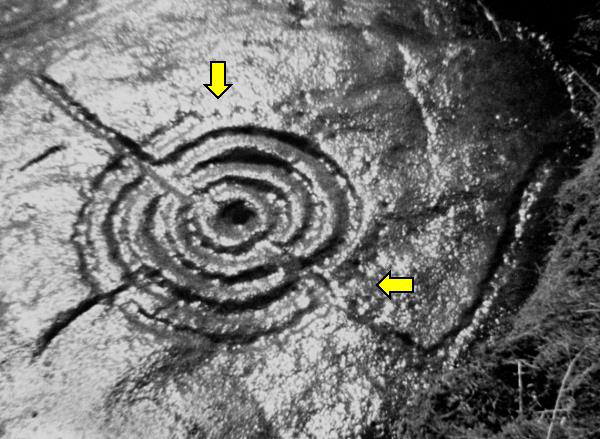 |
Figure 18. Cup-and-ring petroglyph from Buttony, Northumberland, England, showing the semi-circle of small dots of the unfinished petroglyph between the two yellow arrows. Photograph © by Maarten van Hoek. |
Conclusions
First of all it proves that there
are some more rock art images in Andean rock art that are composed of only dots
or small cupules. Yet, sometimes it is difficult to decide whether an image was
made of dots or just loosely pecked. An illustrative example is the zoomorphic
petroglyph on Roca
Cucharayacu 4 near Balsapuerto, northern Peru (Orefici 2013: Foto 14).
In general there are three
possibilities. First of all, it is possible that a completely dotted image,
without any (contour) line or fully pecked area, was intended as it is seen on
the rock surface today (Figure 1). Completely dotted images with a (small)
fully pecked body part may as well be premeditated, especially when only the
head is fully pecked (Figure 9). Secondly, dotted zoomorphs may also represent
unfinished images that were intended to be turned into fully pecked images
(Figure 14) or completely outlined images (Figures 15 and 16). Finally, dotted
images may include rows of dots that were intended to be connected in order to
finish the image (Figure 18). It proves that often the graphical context often
determines whether a dotted design was intended to remain dotted, was supposed
to receive an outline or should become fully pecked. In some cases the dots may
have served as a preliminary sketch to be finished at a later stage. Yet, in
many instances it will remain uncertain what actually was the intention of the
manufacturer of the ancient images. However, notwithstanding all sorts of
uncertainties, I am convinced that the dotted Achahui petroglyphs described by
Rainer Hostnig are true examples of dotted zoomorphs.
![]()
—¿Preguntas, comentarios? escriba a: rupestreweb@yahoogroups.com—
Cómo citar este artículo:
En Rupestreweb, http://www.rupestreweb.info/puntiformes.html
2016
REFERENCES
Please be aware that any URL included in this paper (functional as per December 2015) may be broken or even hacked. Please notify me if any broken link occurs.
Aschero,
C. 1988. Pinturas
rupestres, actividades y recursos naturales: un encuentro arqueológico. En: Arqueología Contemporánea Argentina.
Actualidades y Perspectivas. Edic. Búsqueda, pp. 109 - 145, Buenos Aires s.
d Periodo arcaico: cazadores - recolectores y pastores tempranos. The URL provided by Rainer Hostnig (2011) does not function anymore.
In: Rupestreweb. Also
available at Academia.
Rojas, O. M. 2005. “El arte rupestre de Valle de Lasana” (Sectores Pona, Descanso en Lucio y Chacras Viejas). Museo de
Historia Natural
de Calama. Calama, Chile. The URL provided by Rainer Hostnig (2011) does not function anymore. PDF no
longer freely available on-line (anyone may ask the author for a free copy).
